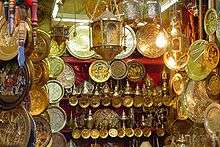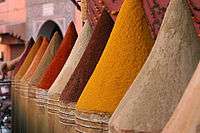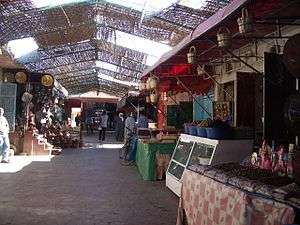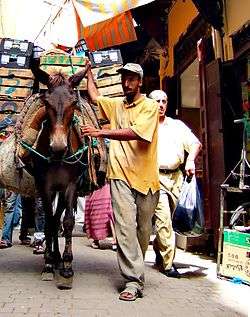Souq
.jpg)
A souq or souk (Arabic: سوق, Hebrew: שוק suq, Hindi: सूक, also spelled shuk, shooq, soq, esouk, succ, suk, sooq, suq) is an open-air marketplace or commercial quarter in Western Asian and North African cities.[1][2] Suq, and sometimes monti, is also used for a marketplace in Malta. The equivalent Persian term is "bazaar".
Etymology
The spelling souk entered European languages probably through French during the French occupation of the Arab countries Morocco, Algeria, and Tunisia in the 19th and 20th centuries. Thus, the word "souk" most likely refers to Arabic/North African traditional markets. Other spellings of this word involving the letter "Q" (sooq, souq...) were likely developed using English and thus refer to Western Asian/Arab traditional markets, as British colonialism was present there during the 19th and 20th centuries. In Modern Standard Arabic the term al-sooq refers to markets in both the physical sense and the abstract economic sense (e.g., an Arabic-speaker would speak of the sooq in the old city as well as the sooq for oil, and would call the concept of the free market السوق الحرّ as-sūq al-ḥurr).
As in markets generally, prices are commonly set by bargaining between buyers and sellers.
The term is often used to designate the market in any Western Asian city, but may also be used in Western cities, particularly those with a Muslim community.
History
A souq was originally an open-air marketplace. Historically, souqs were held outside cities at locations where incoming caravans stopped and merchants displayed their goods for sale. Souqs were formed whenever a caravan or caravans arrived. Since this might be infrequent, souqs often extended beyond buying and selling goods to include major festivals involving various cultural and social activities. Any souq may serve a social function as being a place for people to meet in, in addition to its commercial function.
Later, due to the importance of marketplaces and the growth of cities, the major locations of souqs shifted to urban centers.
In tribal areas, neutrality from tribal conflicts was usually declared for the period of operation of a souk to permit the unhampered exchange of surplus goods.
Types
- Souks

 Souk in Tunis
Souk in Tunis- Souq El Mushir Street Tripoli
- A Syrian man wearing traditional cloths serving Liquorice juice in Homs Market
- The traditional tagine clay pot, used to cook tajine (dish)
- Souks in Marrakech
- Souqs of Marrakech
Seasonal
.jpg)
A seasonal souq is held at a set time that might be yearly, monthly or weekly. The oldest souqs were set up annually, and were typically general festivals held outside cities. For example, Souq Ukadh was held yearly in pre-Islamic times in an area between Mecca and Ta’if during the sacred month of Dhu al-Qi'dah. While a busy market, it was more famous for its poetry competitions, judged by prominent poets such as Al-Khansa and Al-Nabigha. An example of an Islamic annual souq is Al Mirbid just outside Basra, also famed for its poetry competitions in addition to its storytelling activities.
Changes in political, economic and social styles have left only the small seasonal souqs outside villages and small towns, primarily selling livestock and agricultural products.
Weekly markets have continued to function throughout the Arab world. Most of them are named from the day of the week on which they are held. They usually have open spaces specifically designated for their use inside cities. Examples of surviving markets are the Wednesday Market in Amman that specializes in the sale of used products, the Ghazl market held every Friday in Baghdad specializing in pets; the Fina’ Market in Marrakech offers performance acts such as singing, music, acrobats and circus activities.
Permanent
These are more common but less famous as they focus on commercial activity, not entertainment. Until the Umayyad era, permanent souqs were merely an open space where merchants would bring in their movable stalls during the day and remove them at night; no one had a right to specific pitch and it was usually first-come first-served. During the Umayyad era the governments started leasing, and then selling, sites to merchants. Merchants then built shops on their sites to store their goods at night. Finally, the area comprising a souq might be roofed over. With its long and narrow alleys, al-Madina Souq is the largest covered historic market in the world, with an approximate length of 13 kilometers.[3] Al-Madina Souq is part of the Ancient City of Aleppo, a UNESCO World Heritage Site since 1986.[4]

- Souq entrance in Jerusalem
 Spice Market, Marakesh.
Spice Market, Marakesh. Ouarzazate souq.
Ouarzazate souq..jpg) Covered souks in Bur Dubai
Covered souks in Bur Dubai Souq in Tripoli
Souq in Tripoli Marakesh
Marakesh.jpg) Souq in Rabat, Morocco
Souq in Rabat, Morocco
Organisation
Souqs are traditionally divided into specialized sections dealing in specific types of product, in the case of permanent souqs each usually housed in a few narrow streets and named after the product it specializes in such as the gold souq, the fabric souq, the spice souq, the leather souq, the copy souq (for books), etc. This promotes competition among sellers and helps buyers easily compare prices.
At the same time the whole assembly is collectively called a souq. Some of the prominent examples are Souq Al-Melh in Sana'a, Manama Souq in Bahrain, Bizouriyya Souq in Damascus, Saray Souq in Baghdad, Khan Al-Zeit in Jerusalem, and Zanqat Al-Niswaan in Alexandria.
Though each neighbourhood within the city would have a local Souq selling food and other essentials, the main souq was one of the central structures of a large city, selling durable goods, luxuries and providing services such as money exchange.
Workshops where goods for sale are produced (in the case of a merchant selling locally-made products) are typically located away from the souq itself.
The souq was a level of municipal administration. The Muhtasib was responsible for supervising business practices and collecting taxes for a given souq while the Arif are the overseers for a specific trade.
See also
References
| Look up souq in Wiktionary, the free dictionary. |
| Wikimedia Commons has media related to Souqs. |
- ↑ "Aleppo.us: Old souqs of Aleppo (in Arabic)".
- ↑ "Mahane Yehuda website". Retrieved September 6, 2012.
- ↑ "eAleppo: The old Souqs of Aleppo (in Arabic)". Esyria.sy. Retrieved 2013-10-05.
- ↑ "eAleppo:Aleppo city major plans throughout the history" (in Arabic).
